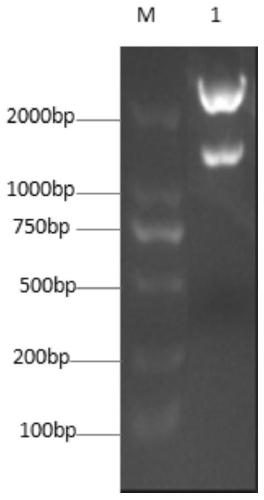CpG-ODN having specific immuno-stimulatory effect on pigs and application thereof
An immune-stimulating and specific technology, applied in the field of CpG-ODN, can solve the problems of inappropriateness and high cost, and achieve the effects of less toxic and side effects of the body, lower production costs, and reduced morbidity
- Summary
- Abstract
- Description
- Claims
- Application Information
AI Technical Summary
Problems solved by technology
Method used
Image
Examples
Embodiment 1
[0032] The screening of embodiment 1 specificity CpG-ODN
[0033] 1. This example uses existing genetic engineering or chemical methods to design and synthesize more than 50 CpG motifs (parts are shown in Table 1), and the rapid determination of IFN-r and SI in peripheral blood mononuclear cells is efficient and reliable. The directional screening mode of the method was used to screen out the best porcine CpG motif (results are shown in Table 2).
[0034] Table 1 Structural features of porcine-specific CpG ODN screened in vitro
[0035]
[0036]
[0037] Note: CpG motifs are underlined, where lowercase letters indicate modified with thio, and uppercase letters indicate not modified with thio.
[0038] Table 2 Stimulation effect of different pig-specific CpG ODNs on pig PBMC in vitro
[0039]
[0040]
[0041] Note: The above data is the average value of 5 individuals; the same letter means no significant difference p>0.05, different letters mean significant differe...
Embodiment 2
[0050] The nucleotide sequence of CpG-ODN (SEQ ID NO: 1) can be synthesized by existing genetic engineering or chemical methods. After synthesis, construct the pFAR4-CpG recombinant plasmid, and connect the nucleotide sequence (SEQ ID NO: 1) of the target gene CpG to the pFAR4 fragment (such as Figure 2-4 shown), the recombinant plasmid was obtained and stored at -15°C for future use.
[0051] A preparation for treating and / or preventing porcine diseases, said preparation is a sterile PBS solution containing 30 μg / mL of the above recombinant plasmid (ie pFAR4-CpG preparation).
[0052] Described aseptic PBS solution (1L) also contains each component of following percentage by weight: 0.6%NaCl, 0.01%KCl, 0.0124%Na 2 HPO 4 , 0.014% KH 2 PO 4 , the balance deionized water.
[0053] The preparation method of the sterile PBS solution is as follows: After mixing the components uniformly in proportion, they are sterilized at 115° C. for 20 minutes by a damp heat autoclaving met...
Embodiment 3
[0057] The nucleotide sequence of CpG-ODN (SEQ ID NO: 1) can be synthesized by existing genetic engineering or chemical methods. After synthesis, construct the pFAR4-CpG recombinant plasmid, and connect the nucleotide sequence (SEQ ID NO: 1) of the target gene CpG to the pFAR4 fragment (such as Figure 2-4 shown), the recombinant plasmid was obtained and stored at -15°C for future use.
[0058] A preparation for treating and / or preventing porcine diseases, said preparation is a sterile PBS solution containing 30 μg / mL of the above recombinant plasmid (ie pFAR4-CpG preparation).
[0059] Described aseptic PBS solution (1L) also contains each component of following percentage by weight: 0.7%NaCl, 0.02%KCl, 0.0134%Na 2 HPO 4 , 0.024% KH 2 PO 4 , the balance deionized water.
[0060] The preparation method of the sterile PBS solution is as follows: After mixing the components uniformly in proportion, they are sterilized at 117° C. for 21 minutes by a damp heat autoclaving met...
PUM
 Login to View More
Login to View More Abstract
Description
Claims
Application Information
 Login to View More
Login to View More - R&D
- Intellectual Property
- Life Sciences
- Materials
- Tech Scout
- Unparalleled Data Quality
- Higher Quality Content
- 60% Fewer Hallucinations
Browse by: Latest US Patents, China's latest patents, Technical Efficacy Thesaurus, Application Domain, Technology Topic, Popular Technical Reports.
© 2025 PatSnap. All rights reserved.Legal|Privacy policy|Modern Slavery Act Transparency Statement|Sitemap|About US| Contact US: help@patsnap.com



